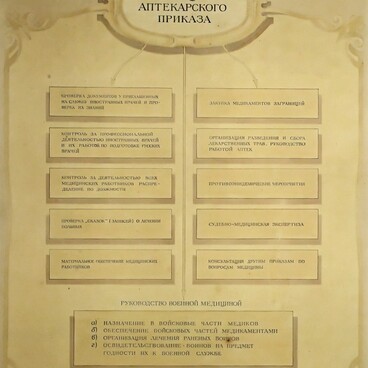In 1950, the Leningrad artist Shorygin created the scheme of the road motor ambulance that is now housed in the museum. He based the scheme on a drawing from the July 1904 issue of the Military Medical Journal.
The drawing was a supplement to the article by the Doctor of Medicine Alexander Andrzheevsky, a senior physician of the 34th Sevsky Infantry Regiment. Andrzheevsky wrote about the disadvantages of modern means of evacuating the wounded. Because of road bumps, traveling long distances in infantry ambulance wagonettes was agonizing even for a healthy person, and it was almost a death sentence for the seriously wounded. More stable wagons could carry only one or two people at a time.
Andrzheevsky proposed his personal project of a road motor ambulance. According to his concept, ten separate motor carriages formed together an ambulance train. There were two tiers of benches with cushioned seats in each carriage, and the top bench could be raised if necessary. Thus, it was possible to transport eight sitting or four lying wounded soldiers in one vehicle, and the whole train could accommodate up to 40 or 80 people at a time.
In addition to the transport carriages, the ambulance motor train was supposed to have an infirmary carriage. There, medical staff applied bandages and performed minor urgent surgeries. The infirmary was divided in half by a removable canvas partition. On the left side, there was a doctor and a train commandant, on the right side there was a dressing table, boxes for storing materials and tools, and a device for boiling water. A supply of food was also stored here.
The maximum speed of such a motor ambulance could vary from 5 to 30 versts (a Russian unit of distance) per hour — that is, 5–37 kilometers per hour. Evacuation, even at high speed, remained safe for the wounded: inflated tires and triple leaf springs dampened shocks, jolts and minor vibrations.
According to Andrzheevsky’s calculations, within a month such road train could evacuate 1,200 lightly wounded or 600 seriously wounded soldiers, while only 180 patients could be evacuated using the ambulance wagonettes.
The road train was supposed to be attended by the chief driver-engineer, who knew the structure of a motor car, as well as the train commandant and the doctor. A driver-engineer and a paramedic were assigned to each carriage.
After the publication of the article, Andrzheevsky’s project was taken over by the Engineering Department of the Main Intendance Directorate, but the ambulance road train was never built.
The drawing was a supplement to the article by the Doctor of Medicine Alexander Andrzheevsky, a senior physician of the 34th Sevsky Infantry Regiment. Andrzheevsky wrote about the disadvantages of modern means of evacuating the wounded. Because of road bumps, traveling long distances in infantry ambulance wagonettes was agonizing even for a healthy person, and it was almost a death sentence for the seriously wounded. More stable wagons could carry only one or two people at a time.
Andrzheevsky proposed his personal project of a road motor ambulance. According to his concept, ten separate motor carriages formed together an ambulance train. There were two tiers of benches with cushioned seats in each carriage, and the top bench could be raised if necessary. Thus, it was possible to transport eight sitting or four lying wounded soldiers in one vehicle, and the whole train could accommodate up to 40 or 80 people at a time.
In addition to the transport carriages, the ambulance motor train was supposed to have an infirmary carriage. There, medical staff applied bandages and performed minor urgent surgeries. The infirmary was divided in half by a removable canvas partition. On the left side, there was a doctor and a train commandant, on the right side there was a dressing table, boxes for storing materials and tools, and a device for boiling water. A supply of food was also stored here.
The maximum speed of such a motor ambulance could vary from 5 to 30 versts (a Russian unit of distance) per hour — that is, 5–37 kilometers per hour. Evacuation, even at high speed, remained safe for the wounded: inflated tires and triple leaf springs dampened shocks, jolts and minor vibrations.
According to Andrzheevsky’s calculations, within a month such road train could evacuate 1,200 lightly wounded or 600 seriously wounded soldiers, while only 180 patients could be evacuated using the ambulance wagonettes.
The road train was supposed to be attended by the chief driver-engineer, who knew the structure of a motor car, as well as the train commandant and the doctor. A driver-engineer and a paramedic were assigned to each carriage.
After the publication of the article, Andrzheevsky’s project was taken over by the Engineering Department of the Main Intendance Directorate, but the ambulance road train was never built.



